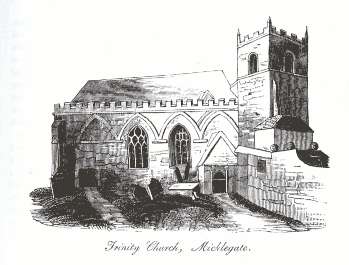
It is appropriate that any tour of Haunted York should begin with this church, for it is the setting of what has become one of the most famous of all the ghost stories connected with the city. Ever since the Rev. S. Baring Gould, the writer of "Onward, Christian soldiers", first collected the many eye witness accounts in his book "Yorkshire Oddities", this particular haunting has always been included in ghostly guides to the north country. It is unique in that mention of it is even made on the church information board attached to the gate.
The church has been much altered since the time of the hauntings, although enough of the structure remains to enable us to imagine the scene when the gallery at the west end of the nave gave such a clear view of the phenomena at the east. It must be remembered, however, that the present east window is not the one about which the story is told, nor is it in the original position. The present chancel was built about 1886 on the site of the great central tower of the original priory church.
Three very distinct figures were seen, always in broad daylight, and generally during the hours of morning service. One of the figures, referred to as the mother, was tall and graceful, eighteen to twenty years of age, her face covered with a fine lace veil. This was the figure who showed such affection and despair. The second figure was described as a nursemaid, showing loving care of a child which she brings to the mother. Legend says that a father, mother and child lived near the church. When the father died, he was buried near the east window, but the child,
dying later, had to be buried outside the city walls because of plague regulations. Soon afterwards the mother died and was buried in the husband's grave, "now, she continues to seek for her child and bemoan the separation".
In 1957, an incident occurred which was reported to Mr. John Mitchell, the author of ' Ghosts of an Ancient City' by a teacher of religious knowledge in a local school. This lady, during one of York's festivals, was showing a keen historian round some of the ancient churches of York. About nine o'clock in the evening, the two ladies came to Holy Trinity Church in the gathering dusk, neither of them knowing of the traditions of haunting connected with the building. As the historian examined the monuments and the fabric of the building, her friend stood, somewhat tired, in the crossing at the west end of the church, underneath the place where the gallery used to be. Suddenly she noticed the atmosphere change to what she described as "earthy and cold, an atmosphere of death and decay". It was not until 1964 that she heard of the tradition of haunting in the church and decided to visit the building once again. This time all was well, and the atmosphere was free of any unpleasant aromas.
Another tradition tells us that in the troubled days of Henry VIII, a party of soldiers, coming to take possession of the convent once attached to this community, met spirited reproval from the prioress, who barred the way and told them that only over her dead body would they enter God's property. Her courage resulted in her being cut down by their swords, though she vowed before dying that her spirit would haunt the site until what belonged to God was restored. Unfortunately the legend must remain unfounded, for the convent attached to the priory was St. Clement's in Clementhorpe and we know that the last prioress was Isabel Warde who lived in a house in Trinity Lane, leaving it to the poor of the parish when she died. The house still stands in the narrow lane to the east of the church and is in use, with the delightful name of "Jacob's Well", for meetings.